Automated Gold Grain Counting. Part 2: What a Gold Grain Size and Shape Can Tell!
Abstract
:1. Introduction
2. Database and Acquisition Procedures
2.1. Grain Size Measurement
2.2. Shape Analysis
3. Discussion
3.1. Similarity of Size Distribution
3.2. Fine-Grained Gold Elutriation
3.3. Morphology Changes with Transport
3.4. Meaning of the Different Pristine Morphofacies
4. Conclusions
- Grain size distribution approximately follows a log-normal distribution that is bounded by the instrumental limitations at 1 mm due to sieving and approximately 10 µm due to recovery limitations. This grain size distribution is relatively constant between surveys, areas and deposits. Discrimination of grains from dispersion train versus background signal requires detailed statistical analysis such as Student tests. However, it can efficiently be used without advanced statistics to detect sampling or processing issues.
- Gold grain size distribution obtained in lodgment tills is similar to size distribution in source rocks if such a material is process with the same laboratory procedure.
- No significant difference is noted between gold grain size distribution from various types of glacial sediments, except for high energy alluvial or beach sediments. It suggests that gold grain elutriation by natural processes occurs only at sizes smaller than what can be recovered by heavy mineral concentration procedures. Ablation and lodgment tills from an area constitute a uniform population in this regard and do not require separated statistical interpretations. No significant fine-grained gold loss is noted for samples collected by reverse circulation drilling.
- Gold grain shape is dictated by their relation with neighboring minerals in the source rock, which is rather well preserved by erosion and transport. Four morphofacies are here introduced: “Mutual” grains that are rounded droplet typically found in sulfides; “Crystalline” grains that have at the least partially developed the cubic crystalline habits and considered as originating dominantly from unconstrained growth in quartz or carbonates; “Intergranular” grains with complex shapes, which are dictated by neighboring minerals boundaries; and “remobilized” grains that are leaflets and flakes that filled cracks in other minerals. These four morphofacies are subdivisions of the pristine class.
- No significant difference is noted in grain morphofacies abundance between the various type of sediments, except for reworked till, alluvial sediments and beach sediments, where “reshaped” grains are more abundant.
- The relative morphofacies abundance can be used to forecast the association of gold with sulfides and orient geophysical survey and interpretation.
- The rate at which the shape of the grain is modified in the course of sediment transport is dependent on the size of the grain, small grains being less susceptible to deformation. It is also dependent on shape complexity, delicate grains such as remobilized leaflets being more readily modified than rounded mutual grains. This implies that estimation of the transport distance cannot be simply based on the “pristine” to “Modified plus reshaped” grains without taking into account the initial size and shape of the grains. Drawing exploration conclusions on such premises can be misleading.
- Regional gold grain backgrounds typically have a 50–30–20 ratio between “pristine,” “modified” and “reshaped” grains. The presence of a dispersion trains eroded from a local source will typically contribute dominantly to the “intergranular-pristine” grain population, without significant contribution to “reshaped” population. If counts are sufficient to circumvent the intrinsic variance induced by the Poisson distribution, the count of “intergranular” grains provides the best signal-to-noise ratio for interpreting the results.
Supplementary Materials
Author Contributions
Funding
Data Availability Statement
Acknowledgments
Conflicts of Interest
References
- Averill, S.A.; Zimmerman, J.R. The riddle resolved—The discovery of the Partridge Gold Zone using sonic drilling in glacial overburden at Waddy Lake, Saskatchewan. In CIM Bulletin; Canadian Institute of Mining, Metallurgy and Petroleum: Westmount, QC, Canada, 1984; Volume 77, p. 88. [Google Scholar]
- Sarala, P.; Pulkkinen, E.; Ojala, V.J.; Peltoniemi-Taivalkoski, A. Gold exploration using till at Petäjälehto, northern Finland. Geochem. Explor. Environ. Anal. 2009, 9, 247–255. [Google Scholar] [CrossRef]
- McClenaghan, M.B.; Cabri, L.J. Review of gold and platinum group element (PGE) indicator minerals methods for surficial sediment sampling. Geochem. Explor. Environ. Anal. 2011, 11, 251–263. [Google Scholar] [CrossRef]
- Averill, S.A. Discovery and delineation of the rainy river gold deposit using glacially dispersed gold grains sampled by deep overburden drilling: A 20-year odyssey. In New Frontiers for Exploration in Glaciated Terrain; Paulen, R.C., McClenaghan, M.B., Eds.; Open File 7374; Geological Survey of Canada: Ottawa, ON, Canada, 2013; pp. 37–46. [Google Scholar]
- Taivalkoski, A.; Sarala, P.; Hulkki, H. Gold exploration using heavy minerals in till and weathered bedrock in Petäjäselkä, northern Finland. Geochem. Explor. Environ. Anal. 2015, 15, 205–221. [Google Scholar] [CrossRef]
- Dilabio, R.N.W. Classification and interpretation of the shapes and surface textures of gold grains from till. In Gisements Alluviaux d’or (Alluvial Gold Placers/Yacimientos Aluviales de Oro); Geological Survey of Canada Contribution N 32391; ORSTOM: Paris, France, 1991; pp. 297–313. [Google Scholar]
- Harris, D.C. The mineralogy of gold and its relevance to gold recoveries. Miner. Depos. 1990, 25, S3–S7. [Google Scholar] [CrossRef]
- Haycock, H.M. The role of the microscope in the study of gold ores. Can. Inst. Min. Metall. 1937, 40, 405–414. [Google Scholar]
- Sauerbrei, J.A.; Pattison, E.F.; Averill, S.A. Till sampling in the Casa-Berardi gold area, Quebec: A case history in orientation and discovery. J. Geochem. Explor. 1987, 28, 297–394. [Google Scholar] [CrossRef]
- Averill, S.A. Regional variations in the gold content of till in Canada. In Prospecting in Areas of Glaciated Terrain; MacDonald, D.R., Mills, K.A., Eds.; Canadian Institute of Mining and Metallurgy: Montréal, QC, Canada, 1988; pp. 271–284. [Google Scholar]
- Huhta, P. Studies of till and heavy minerals for gold prospecting at Ilomantsi, eastern Finland. In Prospecting in Areas of Glaciated Terrain; MacDonald, D.R., Mills, K.A., Eds.; Canadian Institute of Mining and Metallurgy: Montréal, QC, Canada, 1988; pp. 285–292. [Google Scholar]
- Huhta, P. The use of heavy mineral concentrates from till in gold exploration in the late Archean Hattu Schist belt, Ilomantsi, Eastern Finland. Geol. Surv. Finl. 1993, 17, 363–372. [Google Scholar]
- Girard, R.; Tremblay, J.; Néron, A.; Longuépée, H. Automated gold grain counting. Part 1: Why counts matter! Minerals 2021, 11, 337. [Google Scholar] [CrossRef]
- Boivin, J.-F.; Bédard, L.P.; Longuépée, H. Counting a pot of gold: A till golden standard. J. Geochem. Explor. 2021. submitted. [Google Scholar]
- McClenaghan, M.B. Regional and local-scale gold grain and till geochemical signatures in the Western Abitibi greenstone Belt, central Canada. In Drift Exploration in Glaciated Terrain; Special Publication 185; McClaneagan, M.B., Bobrowsky, P.T., Hall, G.E.M., Cook, S.J., Eds.; Geological Society: London, UK, 2001; pp. 201–223. [Google Scholar]
- Sciuba, M.; Beaudoin, G.; Grzela, D.; Makvandi, S. Trace element composition of scheelite in orogenic gold deposits. Econ. Geol. 2020, 55, 1149–1172. [Google Scholar] [CrossRef]
- Sciuba, M.; Beaudoin, G.; Makvandi, S. Chemical composition of tourmaline in orogenic gold deposits. Econ. Geol. 2020. [Google Scholar] [CrossRef]
- Averill, S.A. Indicator minerals fingerprinting in surficial sediments near Au-Cu deposits of the porphyry-epithermal-volcanogenic suite. In Proceedings of the 26th International Applied Geochemistry Symposium, Rotorua, New Zealand, 17–21 November 2013; pp. 35–44. [Google Scholar]
- Hashmi, S.; Ward, B.C.; Plouffe, A.; Leybourne, M.; Ferbey, T. Geochemical and mineralogical dispersal in till from the Mount Polley Cu-Au porphyry deposit, central British Columbia, Canada. Geochem. Explor. Environ. Anal. 2015, 15, 234–249. [Google Scholar] [CrossRef]
- Plouffe, A.; Ferbey, T.; Hashmi, S.; Ward, B.C. Till geochemistry and mineralogy: Vectoring towards Cu porphyry deposits in British Columbia, Canada. Geochem. Explor. Environ. Anal. 2016, 16, 213–232. [Google Scholar] [CrossRef]
- Plouffe, A.; Ferbey, T. Porphyry Cu indicator minerals in till: A method to discover buried mineralization. In Indicator Minerals in Till and Stream Sediments of the Canadian Cordillera; Ferbey, T., Plouffe, A., Hickin, A.S., Eds.; Geological Association of Canada: Ottawa, ON, Canada, 2017; Volume 50, pp. 129–159. [Google Scholar]
- Clark, J.R.; Williams-Jones, E.W. Rutile as a potential indicator mineral for metamorphosed metallic ore deposits. Divex Final Rep. Sub Proj. SC2 2004. 17 pages. [Google Scholar]
- Dupuis, C.; Beaudoin, G. Discriminant diagrams for iron oxide trace element fingerprinting of mineral deposit types. Miner. Deposita. 2011, 46, 319–335. [Google Scholar] [CrossRef]
- Dare, S.A.S.; Barnes, S.J.; Méric, J.; Néron, A.; Beaudoin, G.; Boutroy, E. The use of trace elements in Fe-oxides as provenance and petrogenetic indicators in magmatic and hydrothermal environments. In Proceedings of the 12th SGA Biennial Meeting, Uppsala, Sweden, 12–15 August 2013; Volume 1, pp. 256–259. [Google Scholar]
- Huang, X.-W.; Boutroy, E.; Makvandi, S.; Beaudoin, G.; Corriveau, L.; Franco De Toni, A. Trace element composition of iron oxides from IOCG and IOA deposits: Relationship to hydrothermal alteration and deposit subtypes. Miner. Depos. 2019, 54, 525–552. [Google Scholar] [CrossRef] [Green Version]
- Huang, X.-W.; Sappin, A.A.; Boutroy, E.; Beaudoin, G.; Makvandi, S. Trace element composition of igneous and hydro-thermal magnetite from porphyry deposits: Relationship to deposit subtypes and magmatic affinity. Econ. Geol. 2019, 114, 917–952. [Google Scholar] [CrossRef]
- Makvandi, S.; Huang, X.W.; Beaudoin, G.; Quirt, D.; Ledru, P.; Fayek, M. Trace element signatures in hematite and goethite from Kiggavik-Andrew Lake Structural Trend uranium deposits and prospects (Nunavut, Canada). Miner. Depos. 2020, 56, 509–535. [Google Scholar] [CrossRef]
- Nadoll, P.; Angerer, T.; Mauk, J.L.; French, D.; Walshe, J. The chemistry of hydrothermal magnetite: A review. Ore Geol. Rev. 2014, 61, 1–32. [Google Scholar] [CrossRef]
- McClenaghan, M.B.; Parkhill, M.A.; Pronk, A.G.; Sinclair, W.D. Indicator mineral and till geochemical signatures of the Mount Pleasant W-Mo-Bi and Sn-Zn-In deposits, New Brunswick, Canada. J. Geochem. Explor. 2017, 172, 151–166. [Google Scholar] [CrossRef] [Green Version]
- McClenaghan, M.B. Indicator mineral methods in mineral exploration. Geochem. Explor. Environ. Anal. 2005, 5, 233–245. [Google Scholar] [CrossRef] [Green Version]
- Hooke, R.L.B.; Cummings, D.I.; Lesemann, J.-E.; Sharpe, D.R. Genesis of dispersal plumes in till. Can. J. Earth Sci. 2013, 50, 847–855. [Google Scholar] [CrossRef]
- Griffin, W.L.; Ryan, C.G. Trace elements in indicator minerals: Area selection and target evaluation in diamond exploration. J. Geochem. Explor. 1995, 53, 311–337. [Google Scholar] [CrossRef]
- McClenaghan, M.B.; Kjarsgaard, B.A. Indicator mineral and geochemical methods for diamond exploration in glaciated terrain in Canada. In Drift Exploration in Glaciated Terrain; McClenaghan, M.B., Bobrowsky, P.T., Hall, G.E.M., Cook, S.J., Eds.; Geological Society: London, UK, 2001; Volume 185, pp. 83–123. [Google Scholar]
- Malkovets, V.G.; Rezvukhin, D.I.; Belousova, E.A.; Griffin, W.L.; Sharygin, I.S.; Tretiakova, I.G.; Gibsher, A.A.; O’Reilly, S.Y.; Kuzmin, D.V.; Litasov, K.D.; et al. Cr-rich rutile: A powerful tool for diamond exploration. Lithos 2016, 265, 304–311. [Google Scholar] [CrossRef]
- Makvandi, S.; Pagé, P.; Tremblay, J.; Girard, R. Exploration for platinum-group minerals in till: A new approach to recovery, counting, mineral identification and chemical characterization. Minerals 2021, 11, 264. [Google Scholar] [CrossRef]
- McClenaghan, M.B.; Paulen, R.G.; Oviatt, N.M. Geometry of indicator mineral and till geochemistry dispersal fans from the Pine Point Mississippi Valley-type Pb-Zn district, Northwest Territories. Can. J. Geochem. Explor. 2018, 190, 69–86. [Google Scholar] [CrossRef]
- Giusti, L. The morphology, mineralogy, and behavior of “fine-grained” gold from placer deposits of Alberta: Sampling and implications for mineral exploration. Can. J. Earth Sci. 1986, 23, 1662–1672. [Google Scholar] [CrossRef]
- Bernier, M.A.; Webber, G.R. Mineralogical and geochemical analysis of shallow overburden as an aid to gold exploration in southwestern Gaspésie, Quebec, Canada. J. Geochem. Explor. 1989, 34, 115–145. [Google Scholar] [CrossRef]
- Nikkarinen, M. Size, form and composition of gold grains in glacial drift in Ilomantsi, eastern Finland. J. Geochem. Explor. 1991, 39, 295–302. [Google Scholar] [CrossRef]
- Saarnisto, M.; Tamminen, E.; Vaasjoki, M. Gold in bedrock and glacial deposits in the Ivalojoki area, Finnish Lapland. J. Geochem. Explor. 1991, 39, 303–322. [Google Scholar] [CrossRef]
- Nikolaeva, L.A.; Nekrasova, A.N.; Milyaev, S.A.; Yablokova, S.V.; Gavrilov, A.M. Geochemistry of native gold from deposits of various types. Geol. Ore. Deposit. 2013, 55, 176–184. [Google Scholar] [CrossRef]
- Grant, A.H.; Lavin, O.P.; Nichol, I. The morphology and chemistry of transported gold grains as an exploration tool. J. Geochem. Explor. 1991, 40, 73–94. [Google Scholar] [CrossRef]
- Nichol, I.; Lavin, O.P.; McClenaghan, M.B.; Stanley, C.R. The optimization of geochemical exploration for gold using glacial till. Explor. Min. Geol. 1992, 1, 305–326. [Google Scholar]
- Goldfarb, R.J.; Groves, D.I. Orogenic gold: Common or evolving fluid and metal sources through time. Lithos 2015, 233, 2–26. [Google Scholar] [CrossRef]
- McQueen, K.G.; Bielin, S.; Lennie, C.A. The Nature of Pyritic Gold Ores at Kalgoorlie, Western Australia: Geological and Metallurgical Implications; James Cook University of North Queensland, Contributions of the Economic Geology Research Unit 51: Townsville, Australia, 1994; p. 42. [Google Scholar]
- Liu, H.; Beaudoin, G.; Makvandi, S.; Jackson, S.E. Geochemical signature of native gold from various Au- bearing deposits -implications for mineral exploration. In Proceedings of the 15th SGA Biennial Meeting, Glasgow, Scotland, UK, 27–30 August 2019; pp. 675–678. [Google Scholar]
- DiLabio, R.N.W. Gold abundances vs. grain size in weathered and unweathered till. Geol. Surv. Can. Pap. 85-1A 1985, 117–122. [Google Scholar] [CrossRef]
- DiLabio, R.N.W. Residence sites of gold, PGE, and rare lithophile elements in till. In Prospecting in Areas of Glaciated Terrain; MacDonald, D.R., Mills, K.A., Eds.; Canadian Institute of Mining and Metallurgy: Montréal, QC, Canada, 1988; pp. 121–140. [Google Scholar]
- Craw, D.P.; Upton, P.; Mackenzie, D.J. Hydrothermal alteration styles in ancient and modern orogenic gold deposits, New Zealand. N. Z. J. Geol. Geophys. 2009, 52, 11–26. [Google Scholar] [CrossRef]
- Shelp, S.G.; Nichol, I. Distribution and dispersion of gold in glacial till associated with gold mineralization in the Canadian Shield. J. Geochem. Explor. 1987, 27, 315–336. [Google Scholar] [CrossRef]
- Sopuck, V.J.; Schreiner, B.T.; Averill, S.A. Drift prospecting for gold in Saskatchewan-use of heavy mineral concentrates in tills. In Gold in the Western Shield; Clark, L.A., Ed.; Canadian Institute of Mining Metallurgy: Montréal, QC, Canada, 1986; Volume 38, pp. 435–469. [Google Scholar]
- McClenaghan, M.B. Regional and local-scale gold grain and till geochemical signatures of lode Au deposits in the western Abitibi Greenstone Belt, central Canada. In Drift Exploration in Glaciated Terrain; McClenaghan, M.B., Bobrowsky, P.T., Hall, G.E.M., Cook, S.J., Eds.; Geological Society: London, UK, 2001; Volume 185, pp. 201–224. [Google Scholar] [CrossRef]
- McClenaghan, M.B.; Plouffe, A.; McMartin, I.; Campbell, J.E.; Spirito, W.A.; Paulen, R.C.; Garrett, R.G.; Hall, G.E.M. Till sampling and geochemical analytical protocols used by the Geological Survey of Canada. Geochem. Explor. Environ. Anal. 2013, 13, 285–301. [Google Scholar] [CrossRef]
- Néron, A.; Girard, R.; Bédard, L.P. Automated Optical Gold Grain Counting: A Quantum Leap; Annual Meeting, Abstract; Geological Association of Canada—Mineralogical Association of Canada: St-John’s, NL, Canada, 2017. [Google Scholar]
- Néron, A.; Girard, R.; Bédard, L.P. ARTPhot: Automated Routine for Grain Counting Using a Digital Microscope and a Neural Network; Annual Meeting, Abstract; Geological Association of Canada-Mineralogical Association of Canada: St-John’s, NL, Canada, 2018. [Google Scholar]
- Girard, R.; Tremblay, J.; Néron, A.; Longuépée, H. Automated gold grain counting: Part 3: The chemical footprint! Minerals 2021. in preparation. [Google Scholar] [CrossRef]
- Wang, W.; Poling, G.W. Methods for recovering fine placer gold. Can. Inst. Min. Metall. Bull. 1983, 76, 47–56. [Google Scholar]
- Cabri, L.J.; Beattie, M.; Rudashevsky, N.S.; Rudashevsky, V.N. Process mineralogy of Au, Pd and Pt ores from the Skaergaard intrusion, Greenland, using new technology. Miner. Eng. 2005, 18, 887–897. [Google Scholar] [CrossRef]
- Mitchell, C.J.; Evans, E.J.; Styles, M.T. A Review of Gold Particle-Size and Recovery Methods; British Geological Survey Technical Report WC/97/14; British Geological Survey: Nottingham, UK, 1997. [Google Scholar]
- Clifton, H.E.; Hunter, R.E.; Swanson, F.J.; Philipps, R.L. Sample Size and Meaningful Gold Analysis; U.S. Geological Survey Professional Paper 625-C; S. Geological Survey: Washington, DC, USA, 1969; pp. C1–C17. [Google Scholar]
- Grammatikopoulos, T.A.; Porritt, L.; Petersen, J.S.; Christensen, K. Mineralogical characterization and process mineralogy of gold bearing rocks from the Nalunaq gold deposit, Greenland. Appl. Earth Sci. 2004, 113, 197–203. [Google Scholar] [CrossRef]
- Dominy, S.C.; Platten, I.M. Gold particle clustering: A new consideration in sampling applications. Appl. Earth Sci. 2007, 116, 130–142. [Google Scholar] [CrossRef]
- Dominy, S.C.; O’Connor, L.; Glass, H.J.; Xie, Y. Geometallurgical study of a gravity recoverable gold orebody. Minerals 2018, 8, 186. [Google Scholar] [CrossRef] [Green Version]
- Dominy, S.C.; Xie, Y.; Platten, I.M. Characterisation of in situ gold particle size and distribution for sampling protocol optimisation. In Proceedings of the Ninth International Congress for Applied Mineralogy, Brisbane, Australia, 8–10 September 2008; pp. 175–185. [Google Scholar]
- Bergman, R.B.; Bill, A. On the origin of logarithmic-normal distributions: An analytical derivation and its application to nucleation and growth processes. J. Cryst. Growth. 2008, 301, 3135–3138. [Google Scholar] [CrossRef] [Green Version]
- Healy, R.E.; Petruk, W. Petrology of Au-Ag-Hg alloy and “invisible” gold in the Trout Lake massive sulfide deposit, Flin Flon, Manitoba. Can. Min. 1990, 28, 189–206. [Google Scholar]
- Sibbick, S.J.; Fletcher, W.K. Distribution and behavior of gold in soils and tills at the Nickel Plate Mine, southern British Columbia, Canada. J. Geochem. Explor. 1993, 47, 183–200. [Google Scholar] [CrossRef]
- Brushett, D. Prospecting under cover: Using knowledge of glacial processes in mineral exploration. Geol. Surv. Nfld. Labrador 2014, 5, 2014. [Google Scholar]
- Néron, A.; Madon, B.; Girard, R. Volumetric Calculation of Minute Gold Grain: Insight from Machine Learning; Annual Meeting Abstract; Geological Association of Canada-Mineralogical Association of Canada: St-John’s, NL, Canada, 2019. [Google Scholar]
- Néron, A.; Tremblay, J.; Girard, R. Convolutional Neuron Network Image Classifier Optimized for Detection of Rare Geological Features: An Example on Gold Grains in Tills; Annual Meeting, Abstract; Geological Association of Canada, Mineralogical Association of Canada: St-John’s, NL, Canada, 2019. [Google Scholar]
- Maitre, J.; Bouchard, K.; Bédard, L.P. Mineral grains recognition using computer vision and machine learning. Comput. Geosci. 2019, 130, 84–93. [Google Scholar] [CrossRef]
- Youngson, J.H.; Craw, D. Variation in placer style, gold morphology, and gold particle behavior down gravel bed-load rivers: An example from the Shotover/Arrow-Kawarau-Clutha river system, Otago, New Zealand. Econ. Geol. 1999, 94, 615–634. [Google Scholar] [CrossRef]
- Townley Brian, K.; Hérail, G.; Maksaev, V.; Palacios, C.; de Parseval, P.; Sepulveda, F.; Orellana, R.; Rivas, P.; Ulloa, C. Gold grain morphology and composition as an exploration tool: Application to gold exploration in covered areas. Geochem. Explor. Environ. Anal. 2003, 3, 29–38. [Google Scholar] [CrossRef] [Green Version]
- Fominykh, P.A.; Nevolko, P.A.; Svetlitskaya, T.V.; Kolpakov, V.V. Native gold from the Kamenka-Barabanowsky and Kharuzovka alluvial placers (Northwest salair ridge, Western Siberia, Russia): Typomorphic features and possible bedrock sources. Ore Geol. Rev. 2020, 126, 103781. [Google Scholar] [CrossRef]
- Liu, H.; Beaudoin, G.; Makvandi, S.; Jackson, S.E.; Huang, X. Multivariate statistical analysis of trace element compositions of native gold from orogenic gold deposits: Implication for mineral exploration. Ore Geol. Rev. 2021, 131, 104061. [Google Scholar] [CrossRef]
- Dilabio, R.N.W.; Newsome, J.W.; McIvor, D.F.; Lowenstein, P.L. The spherical form of gold: Man-made or secondary? Geological Survey of Papua New Guinea, Volcanological Observatory, P.O Box 386, Rabaul, Papua New Guinea. Econ. Geol. 1988, 83, 153–168. [Google Scholar] [CrossRef]
- Patel, H.; Jain, R.; Joshi, M.V. Automatic segmentation and yield measurement of fruit using shape analysis. Int. J. Comput. Appl. Tech. 2012, 45, 19–24. [Google Scholar]
- Schneider, C.A.; Rasband, W.S.; Eliceiri, K.W. NIH Image to ImageJ: 25 years of image analysis. Nat. Methods 2012, 9, 671–675. [Google Scholar] [CrossRef]
- Dürig, T.; Bowman, M.H.; White, J.D.L.; Murch, A.; Mele, D.; Verolino, A.; Dellino, P. Particle shape analyzer PARTISAN–An open-source tool for multi-standard two-dimensional particle morphometry analysis. Ann. Geophys. 2018, 61, 61–66. [Google Scholar] [CrossRef] [Green Version]
- Paulen, R.C. Sampling techniques in the western Canada sedimentary basin and the Cordillera. In Application of Till and Stream Sediment Heavy Mineral and Geochemical Methods to Mineral Exploration in Western and Northern Canada; GAC Short Course Notes 18; Paulen, R.C., McMartin, I., Eds.; Geological Association of Canada: St-John’s, NL, Canada, 2009; pp. 49–73. [Google Scholar]
- Stea, R.; Johnson, M.; Hanchar, D. The geometry of kimberlitic indicator mineral dispersal fans in Nunavut, Canada. Référence sur les trainées palimpsestes, Parent. In Application of Till and Stream Sediment Heavy Mineral and Geochemical Methods to Mineral Exploration in Western and Northern Canada; GAC Short Course Notes 18; Paulen, R.C., McMartin, I., Eds.; Geological Association of Canada: St-John’s, NL, Canada, 2009; pp. 1–13. [Google Scholar]
- Hart, C.J.R. Reduced intrusion-related gold systems. In Mineral Deposits of Canada: A Synthesis of Major Deposit Types, District Metallogeny, the Evolution of Geological Provinces, and Exploration Methods; Goodfellow, W.D., Ed.; Mineral Deposits Division, Special Publication No. 5; Geological Association of Canada: St-John’s, NL, Canada, 2007; pp. 95–112. [Google Scholar]
- Hamilton, S.M. Electrochemical mass-transport in overburden: A new model to account for formation of selective leach geochemical anomalies in glaciated terrain. J. Geochem. Explor. 1998, 63, 155–172. [Google Scholar] [CrossRef]
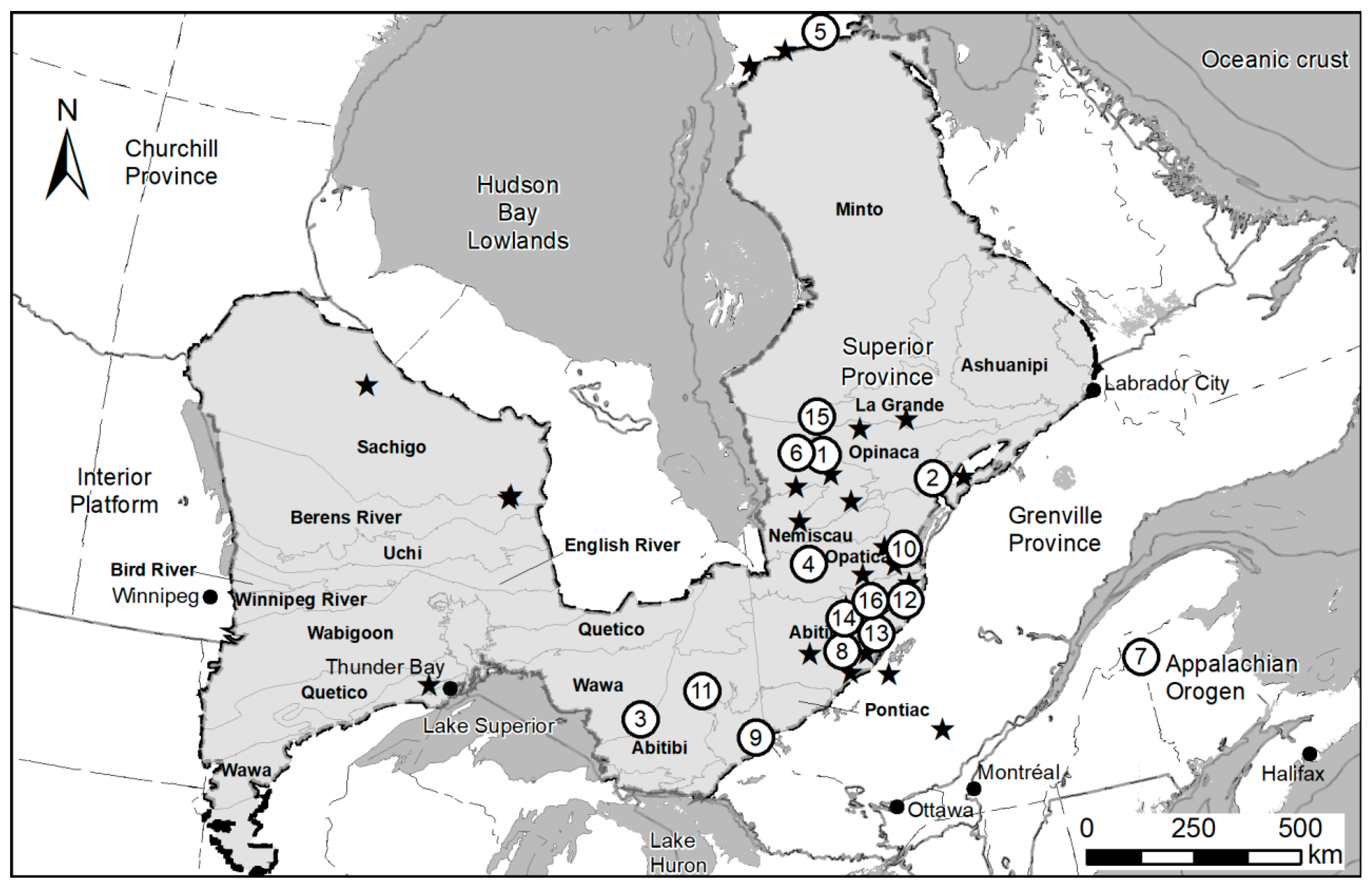
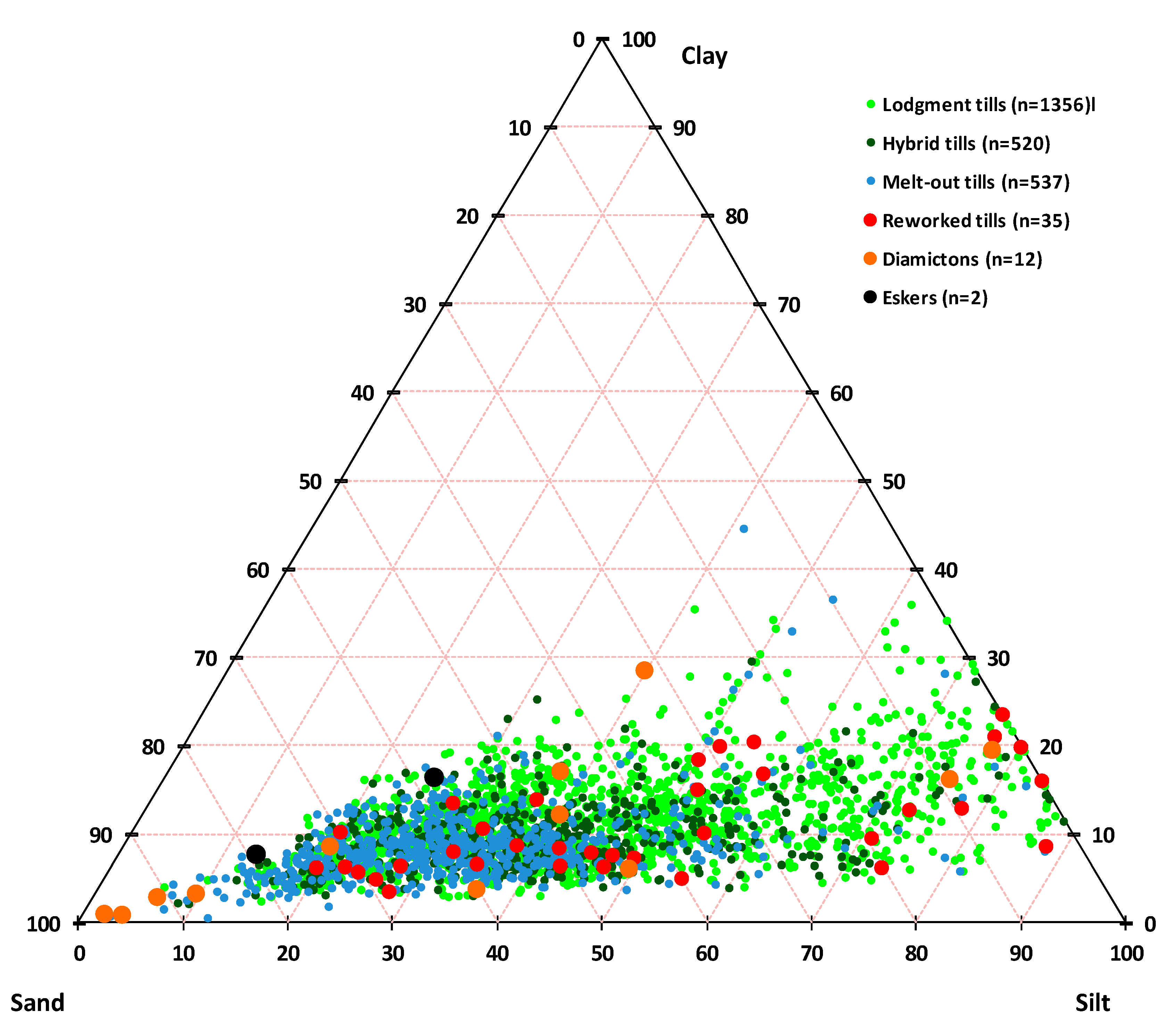
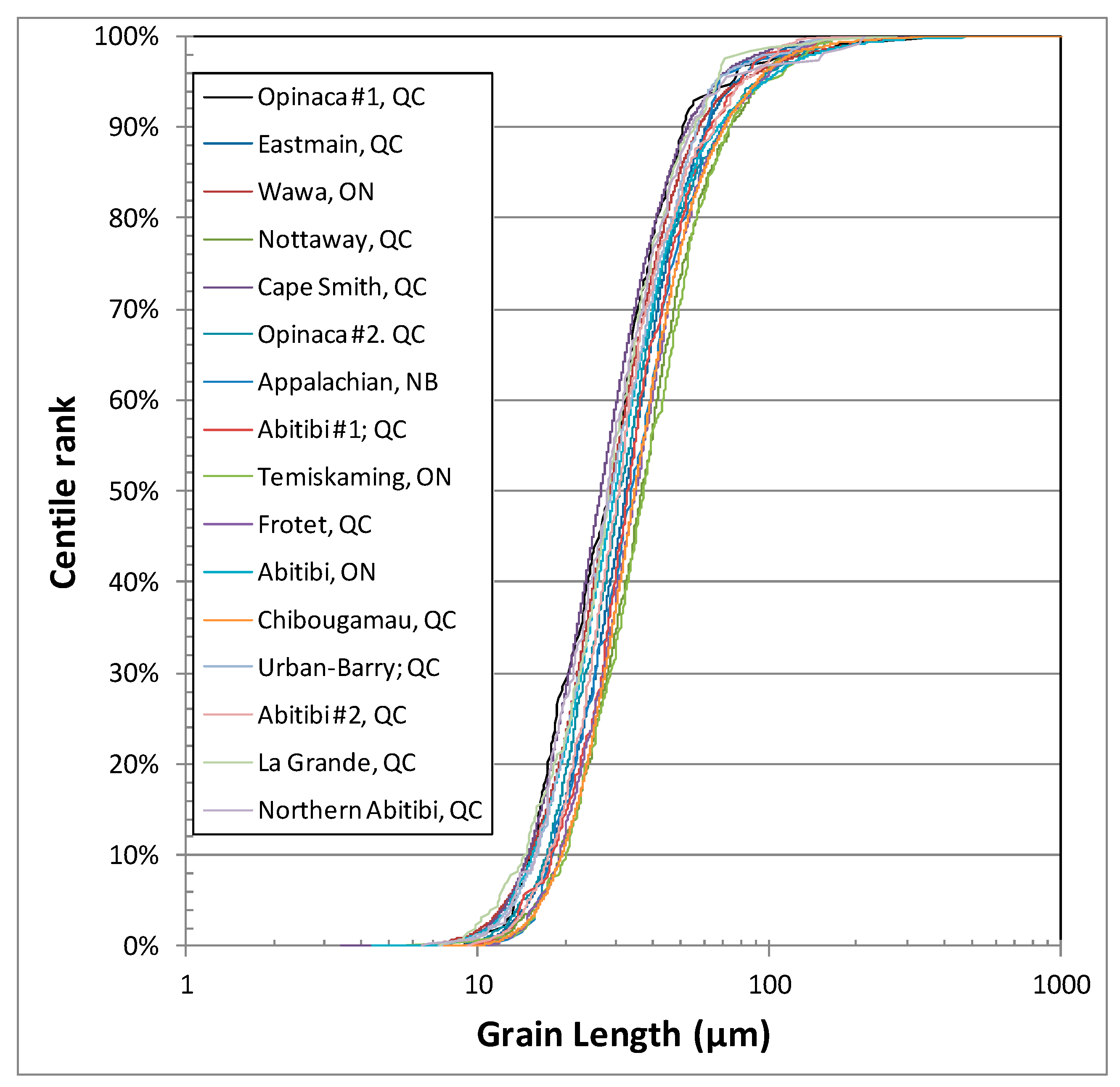
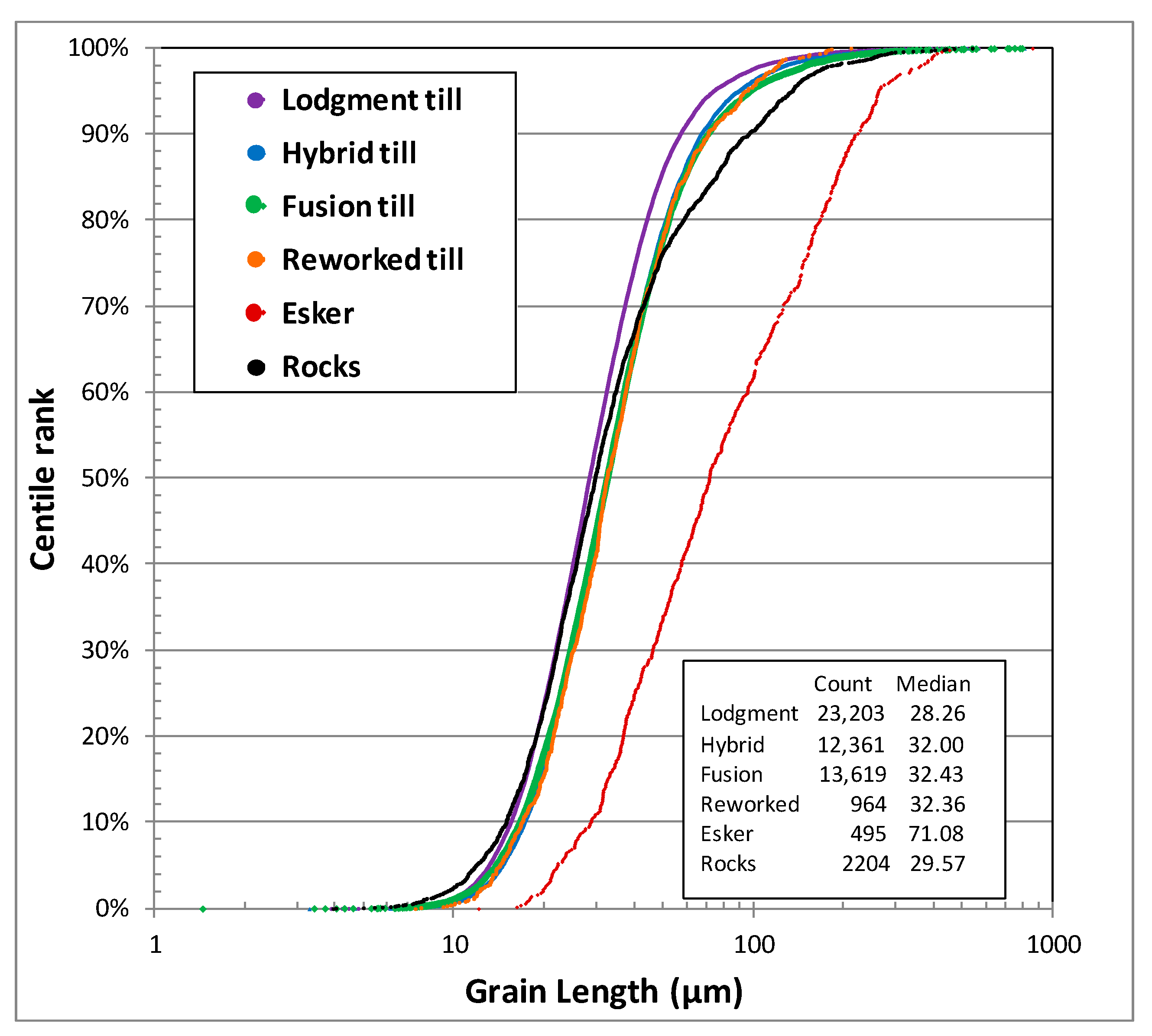
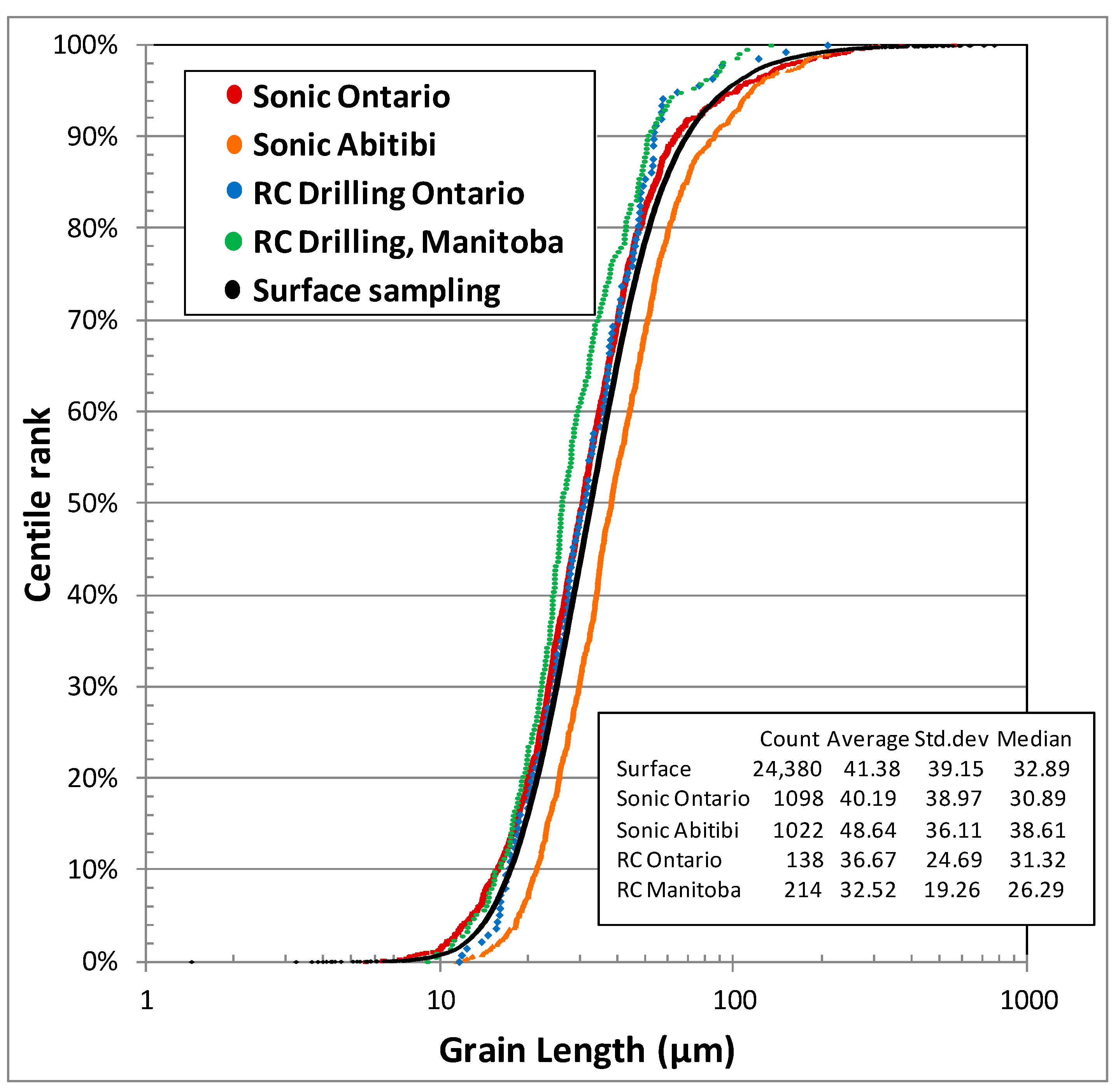





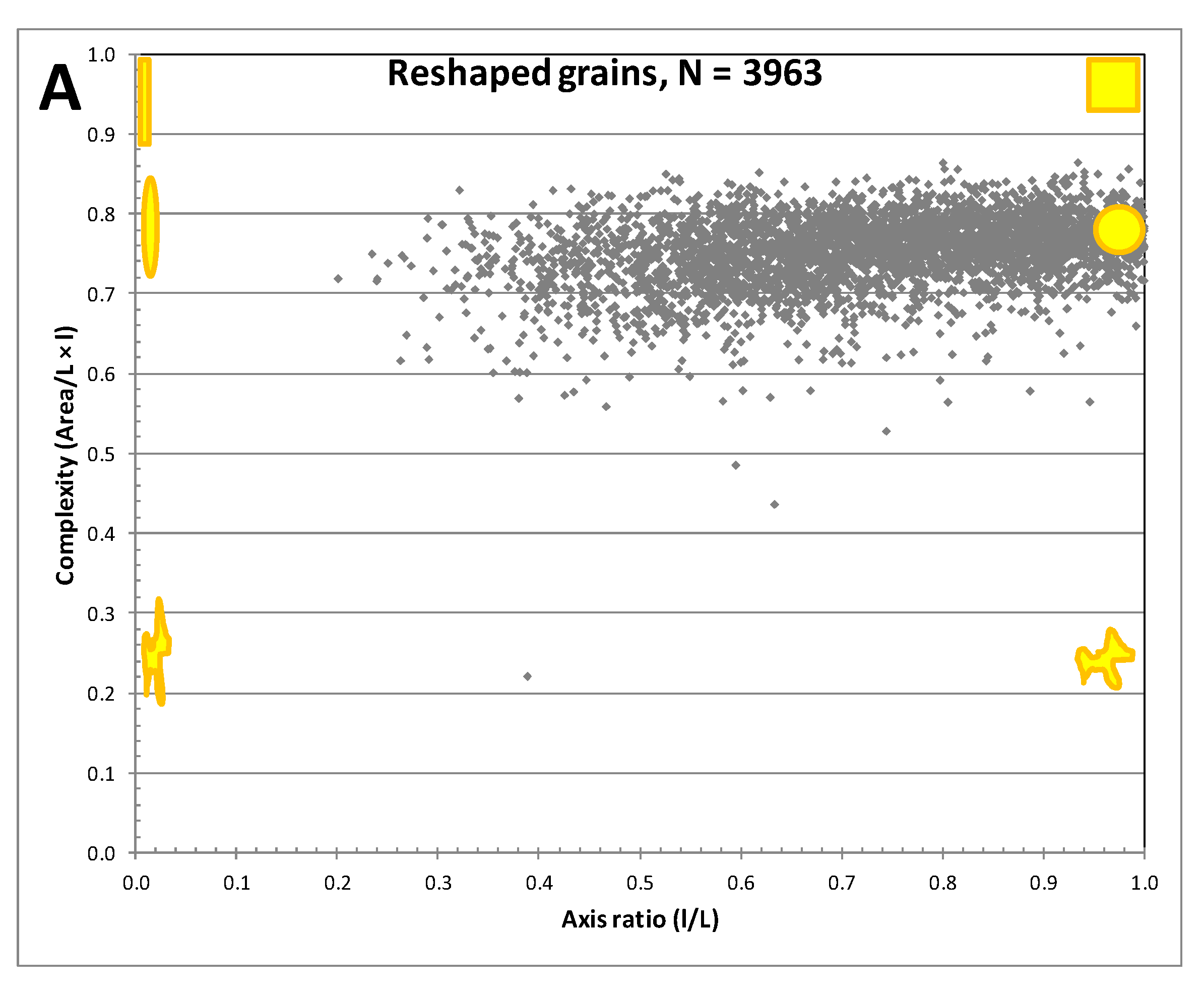
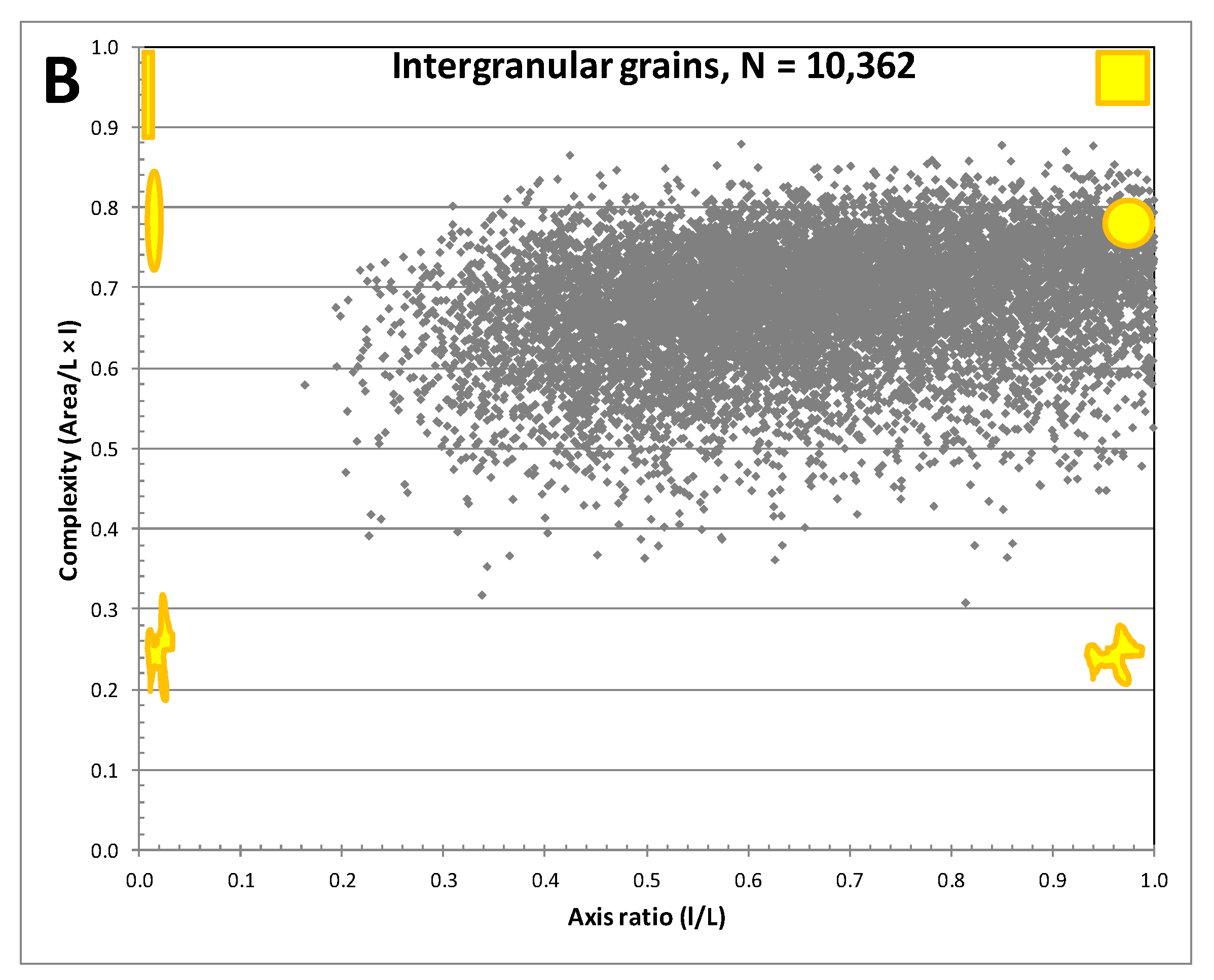
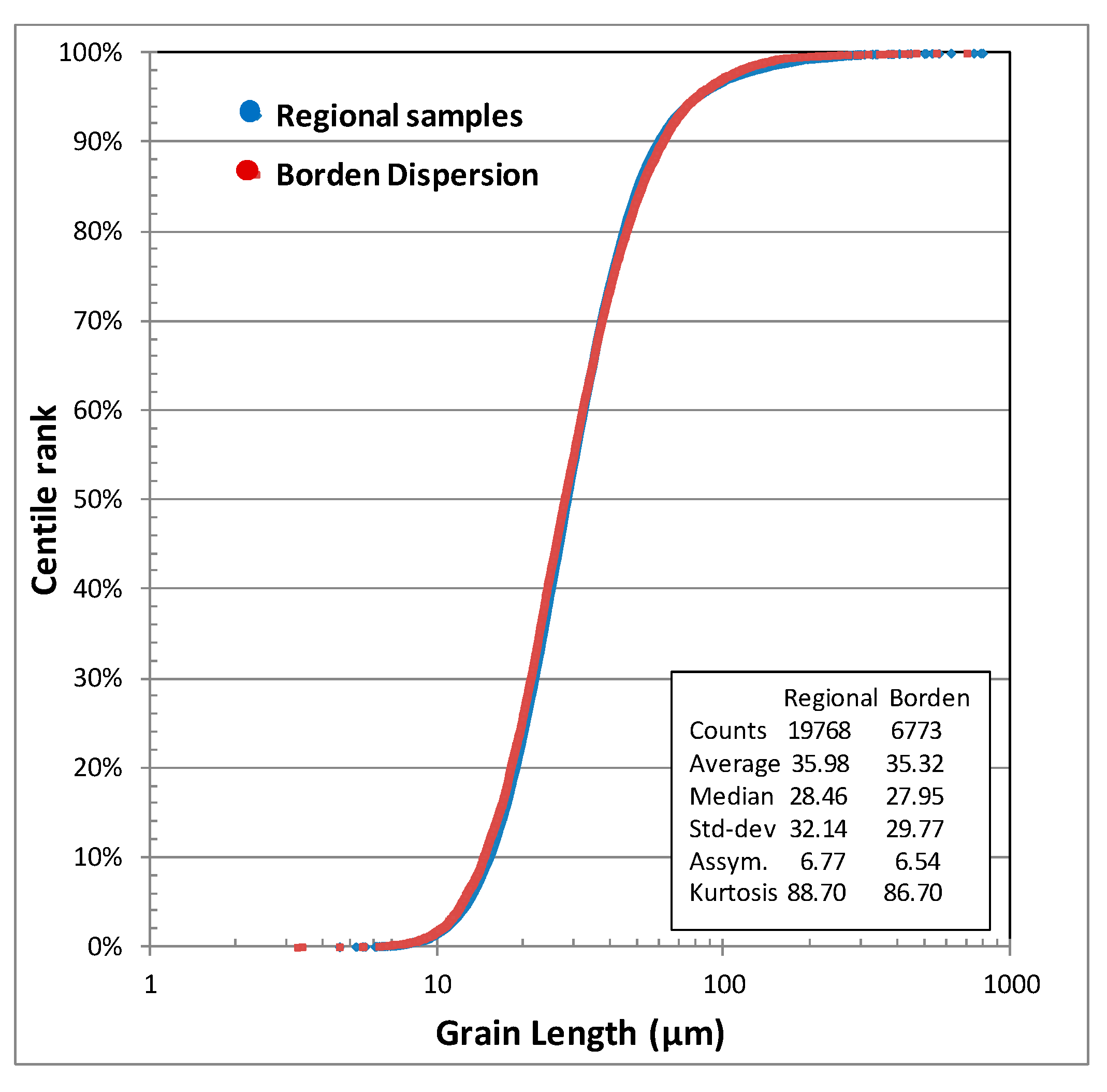
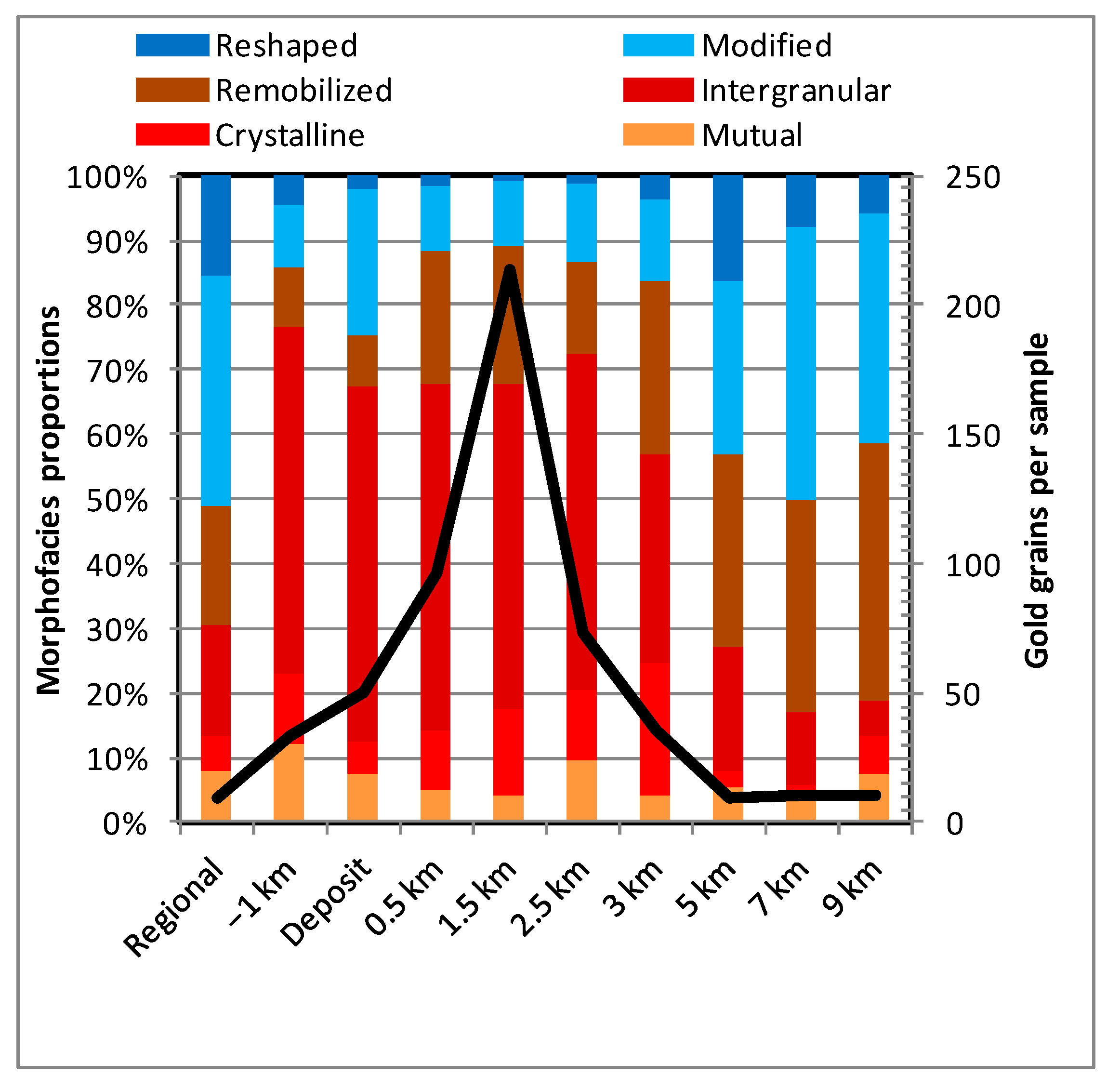
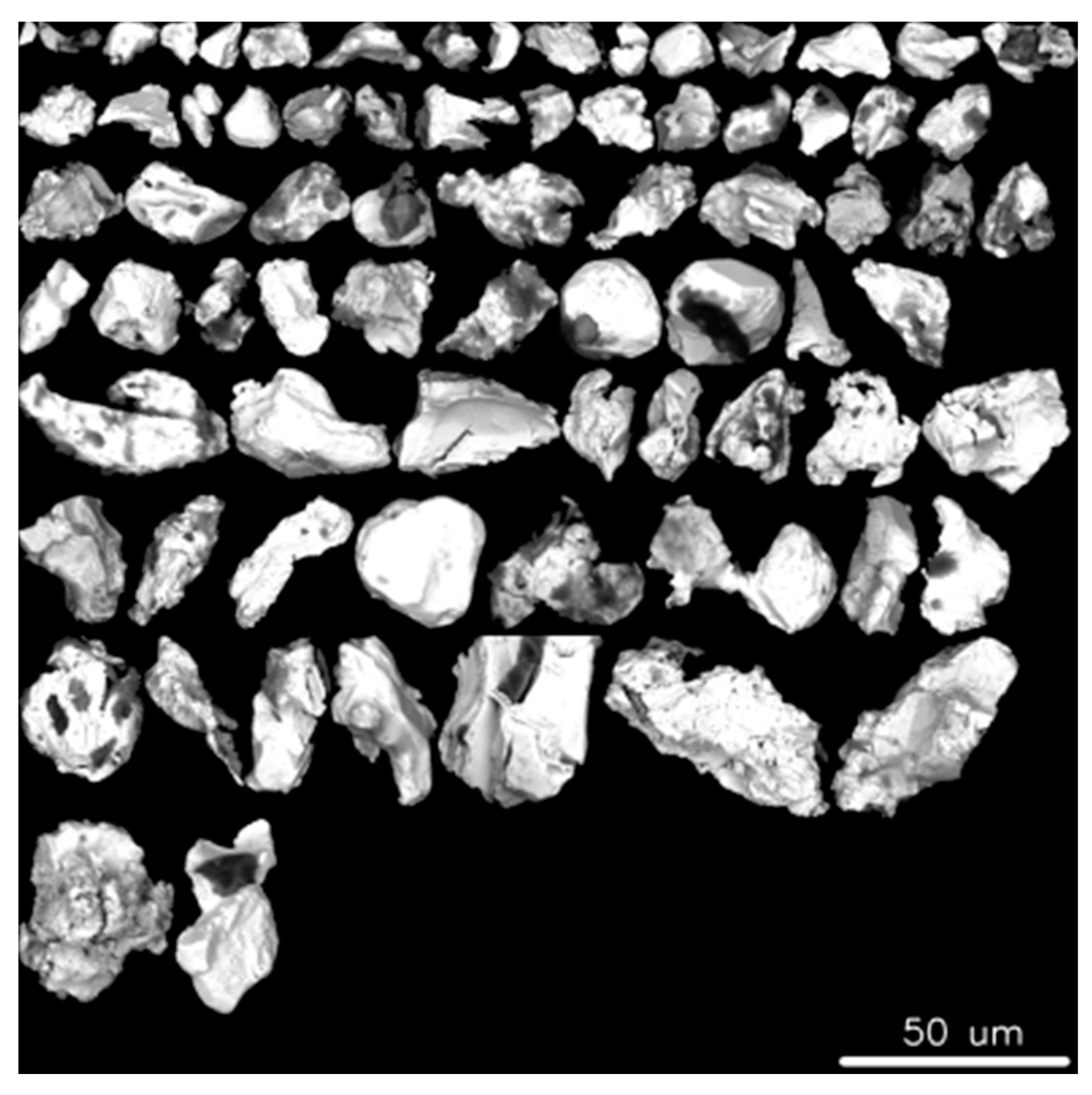
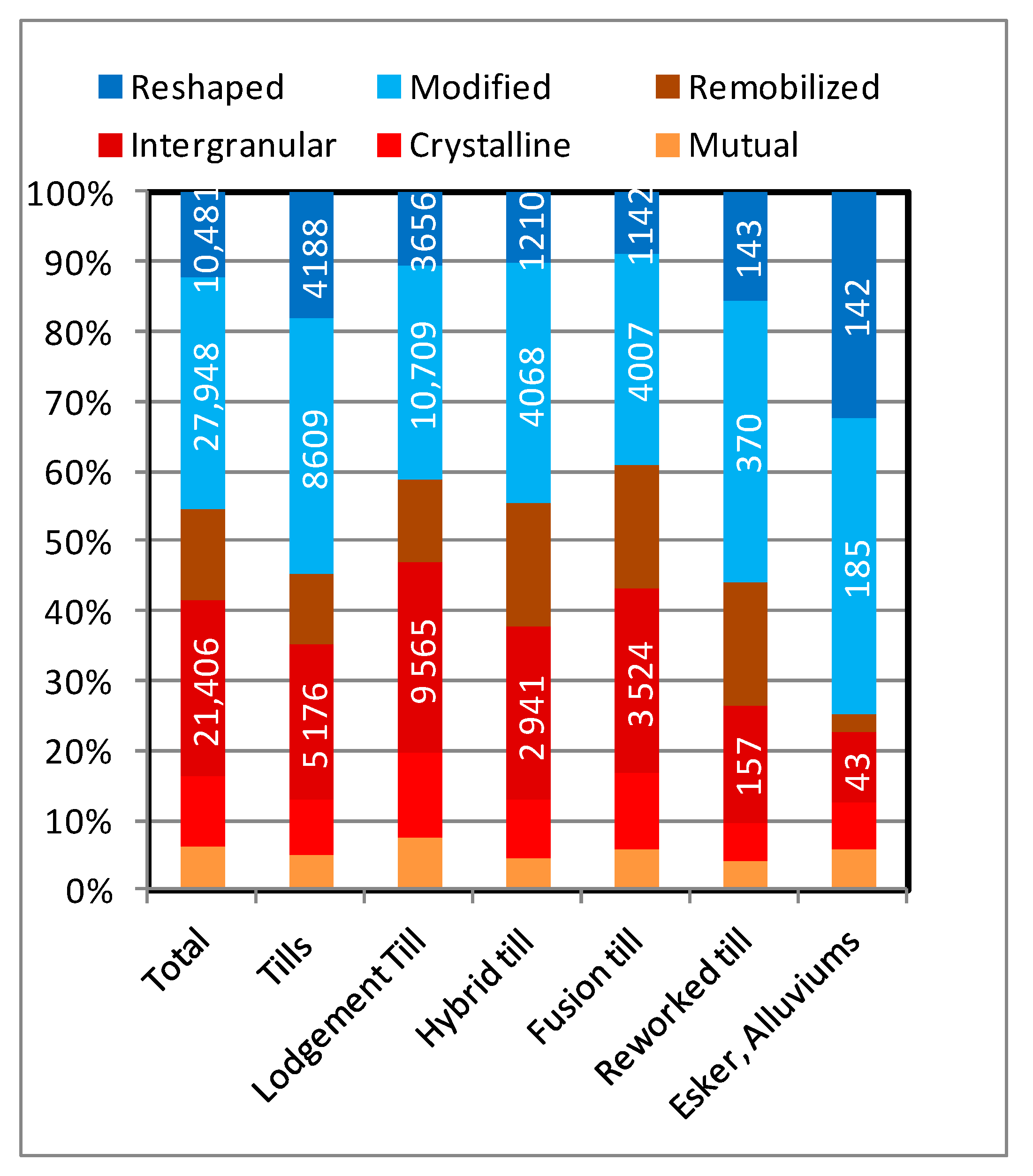


| Survey | Count | Mean | Std-Dev | Median | 1st Centile | 99th Centile | Log-Mean | Log-Std-Dev | Asymetry | Kurtosis |
|---|---|---|---|---|---|---|---|---|---|---|
| Opinaca #1, QC | 243 | 35.0 | 36.7 | 28.3 | 9.6 | 172 | 1.45 | 0.244 | 1.11 | 3.06 |
| Eastmain, QC | 3156 | 37.5 | 22.6 | 32.3 | 11.0 | 125 | 1.52 | 0.216 | 0.32 | 0.48 |
| Wawa, ON | 6501 | 36.1 | 32.3 | 28.5 | 8.9 | 183 | 1.47 | 0.249 | 0.71 | 1.71 |
| Nottaway, QC | 737 | 42.8 | 25.3 | 36.5 | 11.8 | 141 | 1.57 | 0.229 | 0.17 | 0.19 |
| Cape Smith, QC | 11,937 | 31.9 | 23.1 | 26.5 | 9.6 | 115 | 1.44 | 0.224 | 0.53 | 1.08 |
| Opinaca #2, QC | 782 | 38.6 | 27.2 | 30.8 | 10.9 | 155 | 1.51 | 0.241 | 0.57 | 0.41 |
| Appalachian, NB | 137 | 38.8 | 23.2 | 33.5 | 13.1 | 133 | 1.53 | 0.217 | 0.36 | 0.34 |
| Abitibi #1, QC | 343 | 38.6 | 23.6 | 32.8 | 11.9 | 141 | 1.53 | 0.219 | 0.34 | 0.56 |
| Temiskaming. ON | 355 | 43.9 | 27.0 | 37.4 | 12.5 | 146 | 1.58 | 0.234 | 0.16 | 0.46 |
| Frotet, QC | 608 | 41.3 | 25.2 | 35.0 | 13.0 | 138 | 1.55 | 0.223 | 0.42 | 0.14 |
| Abitibi, ON | 4025 | 39.3 | 44.2 | 29.6 | 9.5 | 189 | 1.50 | 0.263 | 0.79 | 1.70 |
| Chibougamau, QC | 4742 | 42.2 | 37.3 | 34.7 | 12.6 | 160 | 1.56 | 0.225 | 0.65 | 1.47 |
| Urban-Barry, QC | 809 | 34.6 | 22.3 | 28.9 | 9.6 | 130 | 1.48 | 0.227 | 0.35 | 0.51 |
| Abitibi #2, QC | 504 | 36.4 | 22.5 | 30.6 | 11.2 | 111 | 1.50 | 0.218 | 0.53 | 0.46 |
| LaGrande, QC | 253 | 33.2 | 24.0 | 28.2 | 8.9 | 119 | 1.45 | 0.233 | 0.29 | 1.11 |
| Northern Abitibi, QC | 225 | 35.2 | 30.2 | 27.9 | 9.9 | 197 | 1.46 | 0.247 | 0.82 | 1.84 |
| Total | 35,357 | |||||||||
| Average | 37.8 | 27.9 | 31.3 | 10.9 | 147.2 | 1.5 | 0.2 | 0.5 | 1.0 | |
| Std-dev | 3.51 | 6.53 | 3.34 | 1.49 | 26.71 | 0.04 | 0.01 | 0.26 | 0.80 | |
| Coef.Variation | 9.3% | 23.4% | 10.7% | 13.7% | 18.1% | 2.9% | 5.9% | 50.9% | 82.6% |
| Sediment Type | Samples | Gold Grains | Grains/Samples | ||
|---|---|---|---|---|---|
| Number | % | Number | % | ||
| Total | 8107 | 100% | 89,613 | 100% | 11.1 gg/s |
| Undiscriminated tills | 3568 | 44% | 27,634 | 28% | 8.0 gg/s |
| Lodgment tills | 2151 | 26.5% | 35,086 | 35% | 16.3 gg/s |
| Hybrid tills | 841 | 10% | 11,967 | 12% | 14.2 gg/s |
| Ablation tills | 1059 | 13% | 13,275 | 13% | 12.5 gg/s |
| Reworked tills | 79 | 1% | 920 | 1% | 11.6 gg/s |
| Diamictons | 28 | 0.5% | 291 | 0.3% | 10.4 gg/s |
| Fluvioglacial | 364 | 4.5% | 435 | 0.4% | 1.2 gg/s |
| Alluvium and beach sand | 17 | 0.2% | 5 | 0.0% | 0.3 gg/s |
| Metallurgical tests (Rocks) | 30 | 9970 | |||
| Nb | Mean | δMean | Median | Std-Dev | Var.Co. | Asym. | Kurtosis | Axis Ratio | Complexity | |
|---|---|---|---|---|---|---|---|---|---|---|
| Total | 84,347 | 41.2 | 0% | 31.5 | 61.8 | 1.5 | 17.6 | 410 | 0.68 | 0.71 |
| Mutual | 5198 | 20.0 | −51% | 17.9 | 10.0 | 0.5 | 2.9 | 17 | 0.72 | 0.75 |
| Cryst. | 8591 | 27.1 | −34% | 23.1 | 15.9 | 0.6 | 3.3 | 20 | 0.71 | 0.75 |
| Interg. | 21,406 | 33.0 | −20% | 28.4 | 20.2 | 0.6 | 4.9 | 57 | 0.66 | 0.68 |
| Remob. | 11,201 | 36.7 | −11% | 32.1 | 23.0 | 0.6 | 5.7 | 87 | 0.60 | 0.67 |
| Modif. | 27,775 | 48.3 | 17% | 37.9 | 43.7 | 0.9 | 11.0 | 290 | 0.69 | 0.71 |
| Reshap. | 10,176 | 66.8 | 62% | 38.9 | 152.8 | 2.3 | 8.4 | 77 | 0.73 | 0.75 |
Publisher’s Note: MDPI stays neutral with regard to jurisdictional claims in published maps and institutional affiliations. |
© 2021 by the authors. Licensee MDPI, Basel, Switzerland. This article is an open access article distributed under the terms and conditions of the Creative Commons Attribution (CC BY) license (https://creativecommons.org/licenses/by/4.0/).
Share and Cite
Girard, R.; Tremblay, J.; Néron, A.; Longuépée, H.; Makvandi, S. Automated Gold Grain Counting. Part 2: What a Gold Grain Size and Shape Can Tell! Minerals 2021, 11, 379. https://doi.org/10.3390/min11040379
Girard R, Tremblay J, Néron A, Longuépée H, Makvandi S. Automated Gold Grain Counting. Part 2: What a Gold Grain Size and Shape Can Tell! Minerals. 2021; 11(4):379. https://doi.org/10.3390/min11040379
Chicago/Turabian StyleGirard, Réjean, Jonathan Tremblay, Alexandre Néron, Hugues Longuépée, and Sheida Makvandi. 2021. "Automated Gold Grain Counting. Part 2: What a Gold Grain Size and Shape Can Tell!" Minerals 11, no. 4: 379. https://doi.org/10.3390/min11040379
APA StyleGirard, R., Tremblay, J., Néron, A., Longuépée, H., & Makvandi, S. (2021). Automated Gold Grain Counting. Part 2: What a Gold Grain Size and Shape Can Tell! Minerals, 11(4), 379. https://doi.org/10.3390/min11040379








